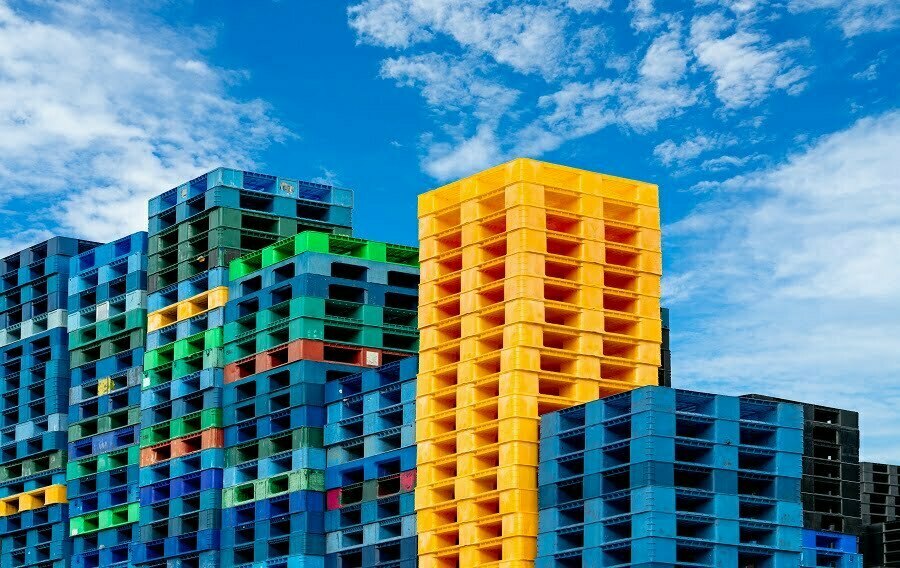Last updated on
Can plastic be recycled into building materials? Yes, it can, and here are 18 ways how it is used in sustainable home construction.
Plastic is used in everything from toys to food packaging to medical devices. It’s also one of the most widely produced manufactured products on Earth. But what happens when we throw away our old plastics or recycle them incorrectly? Can they be reused as new material for buildings? And if so, how can this process happen at scale?
This article explores the different ways how recycled plastic is used in the construction industry.
Plastic Lumber

The first use of recycled plastic was in producing wood composite panels that were then used to build houses. These days, there’s an entire industry dedicated to making these types of panels out of recycled polymers like PET. These panels have been shown to perform better than traditional wooden alternatives because they don’t rot over time. They’re also more resistant to fire damage.
Insulation
In addition to being used in paneling, recycled plastics are often added to insulation rolls made with other materials such as fiberglass. This helps insulate homes against heat loss during cold weather months. They also offer other benefits, including soundproofing, fire resistance, moisture protection, thermal stability, chemical inertness, recyclability, and ease of handling.
Roof Shingles
When it comes to roofing, many people think about asphalt shingles. However, some manufacturers now offer alternative options using recycled plastics instead.
Waterproofing
Many companies make exterior siding by combining recycled plastics with cement. This creates a durable surface that resists water penetration.
Flooring
Recycled plastics can be used to create floor tiles. Mosaic patterns are popular. Plastic can also be used in composite materials to create flooring.
Paving Stones
For those who want something less permanent but still attractive, paving stones might be right up your alley. You could even find recycled plastic ones!
Concrete
Plastic can be used to fortify the concrete for more durable construction. Waste plastic is pulverized into PET particles and used as a more durable substitute for sand.
Building Blocks
Some builders are experimenting with creating their block designs using recycled plastics. It’s like building a real house from Lego!
Bricks
Brickmakers have experimented with recycling plastics for decades. One such example is the EcoBrick. It features layers of different colored recycled plastics stacked together. Each layer adds strength while reducing weight compared to regular clay bricks. Plastic bricks like these could be the prototype for plastic bricks that are strong and durable enough to be used in construction.
Stucco
Another way to add color to walls without having to paint them is through stuccoing. Companies produce precast stucco units that contain recycled plastics.
Masonry
There are several masonry applications where recycled plastics are already commonly found. Examples include pavers, retaining walls, and decorative elements.
Cement
Adding recycled plastics to cement produces stronger mixes that last longer. This makes sense, considering that cement is typically composed of limestone and shale.
Adhesives
As mentioned before, recycled plastics are sometimes mixed with cement to form adhesives. These can help improve bonding between two surfaces.
Paint
Finally, some paints are manufactured from recycled plastics.
PVC Windows and Doors
PVC windows and doors are some of the most common ways to recycle plastic. Most vinyl window and door products consist of three main components: frame, glass or glazing, and trim. The frame holds everything else in place. Glass provides light control and privacy. Trim covers any gaps around the edges of the glass and gives the appearance of a single pane of glass.
Siding
Vinyl siding is another popular option among homeowners looking to increase energy efficiency. While not quite as long-lasting as traditional cedar shake shingle roofs, vinyl siding does require less maintenance over time because it doesn’t rot or need painting. And yes, it can be made of recycled plastic.
Energy Efficiency
Recycled plastic can be used in energy-efficient construction. There are over 36 million tons of post-consumer plastic waste generated each year in the United States alone. Of this amount, only 8% is currently being reused. That means 92% ends up as trash. But what if we told you that almost all of this material could be put back into use when appropriately recycled? What would happen then?
The answer lies in energy efficiency. According to the EPA, the building sector accounts for 76% of total U.S. electricity consumption. By 2030, it’s estimated that more than half of new homes will be built with at least 30% recycled content. With so much potential, why aren’t more people doing it?
Well, first off, not many homeowners know how easy it is. Second, they don’t always understand the benefits. And third, they may believe that other options are better.
How to Recycle Plastic Into Eco Bricks
You may want to know how to recycle plastic bottles or mixed plastic waste into eco-bricks. Here we will introduce you to one method. First, you should know that most plastic products cannot be directly reused due to their complex structure. So if you do not want to throw away all kinds of plastic waste, please try this method. Second, you must pay attention to the following points when processing plastic wastes:
- The temperature during melting process should be controlled strictly. Otherwise, there would be bubbles inside the material.
- After melted, the mixture should be cooled down slowly so as to avoid cracking.
- During cooling process, keep stirring until the whole mass becomes uniform.
- Then, use an extruder machine to press out the shape of bricks.
- Use high quality sandstone powder, then mix well after pressing.
- Add water gradually according to requirement.
- Dry it naturally at room temperature.
- When finished drying, put it under sunlight for about 2 weeks.
- Take care of the surface of the bricks carefully.
- Put on the protective film.
- Store it properly.
- Keep it dry.
- Do not expose it to direct sun light.
- Avoid being exposed to rainwater.
FAQ
Plastic waste amounts to a large part of landfills, and there’s an abundance of it. Secondly, it is relatively easy and inexpensive to recycle it into materials used in construction or as part of other composite materials.
Plastic can be recycled into building blocks, insulation material, and panels and manufacturing other composite building materials.
Table of Contents




